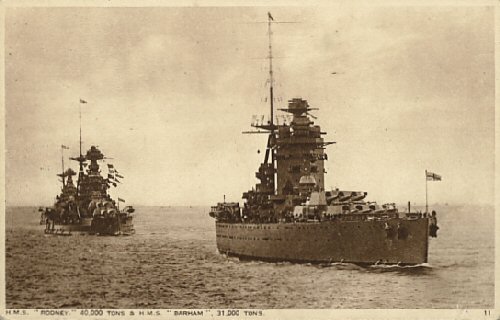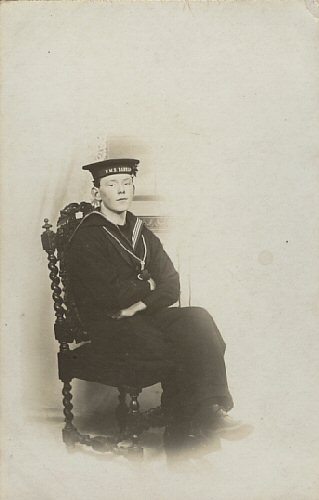
Torpedoed and sunk 25 November 1941
HMS Barham (Battleship, 1915-1941)
The Royal Navy planned to build four fast battleships of the Queen Elizabeth Class but a fifth was added , the Malaya, as a gift of the Malay States. The last of the original four to be laid down was HMS Barham, which was commissioned on 25th August 1915. With a weight of 27,500 tons and planned with a top speed of 25 knots, the ships achieved 24 knots with a power plant 150% greater than the preceding Iron Duke Class.
The original design of the Queen Elizabeth Class presented a very elegant appearance. With balanced twin funnels and classic British tripod, the ships were the epitome of the battleship force of the Royal Navy.
She served in The Grand Fleet during WWI, and at The Battle of Jutland on 31st May 1916 was flagship of Rear-Admiral Sir Hugh Evan-Thomas, commanding the Fifth Battle Squadron. In the battle she received six hits and fired 337 15-Inch rounds. By the end of the War, she was an active member of the British battle fleet.
In 1916, two of Barhams 6" guns were removed and two 3"/20 Mk I guns added. At Jutland she fited 337 shells and took 5 hits in return. In 1918 she was given aircraft platforms on B and X turrets. From 1920 to 1924 she was part of the Atlantic Fleet, and by 1926 the 3" guns were removed and replaced by four 4" Mk V AA guns.
Between 1930 and 1933 she underwent a major refit. Antitorpedo bulges were added, increasing beam to 104' / 31.70m. The two funnels were trunked into one and the deck armour over the magazines was increased to 5". Two octuple 2pdr mountings were also added and two of the torpedo tubes removed, and the aircraft platforms were replaced by a single catapult. These modifications brought the maximum displacement up to 35710 tons.
In 1938 the two remaining torpedo tubes were removed, and the 4" Mk V guns replaced by eight 4" Mk XVI guns in twin mountings. In April 1940 two octuple 2pdr mountings were added. Barham was scheduled for a second major refit in the early 1940s, but the intervention of the war prevented this.
Between the two world wars she was in the Atlantic, Home and Mediterranean Fleets and, at the outbreak of WWII was the flagship of the Vice-Admiral commanding the 1st Battle Squadron and Second-in-Command, Mediterranean at Alexandria.
She was withdrawn from the Mediterranean for Atlantic convoy escort duties and to join the Home Fleet. In December 1939, she formed part of the Home Fleet cover for the first Canadian troop convoy from Halifax to the Clyde. On December 12, 1939 she collided with and sank the destroyer, Duchess.
Two weeks later, on 28th December 1939 she was damaged by a torpedo from U.30 off the West coast of Scotland. She proceeded to Birkenhead for repairs by Cammell Laird & Co. She was out of action for six months.
On 27th August 1940, HMS Barham left Scapa to take part in the expedition for the landing of an Allied military force at Dakar with General de Gaulle in mid-September and, on the 25th, was slightly damaged by by 9.4-Inch and 6.1-Inch shore batteries. In September 1940, she engaged the Vichy French battleship Richelieu in "Operation Menace" at Dakar, Senegal.
After this unsuccessful expedition, she was allocated to the Mediterranean Fleet and left Gibraltar on 7th November, carrying troop reinforcements for Malta, where she arrived on the 10th. During the next twelve months she took part in a number of operations with the Mediterranean Fleet under Admiral Sir Andrew Cunningham.
In January, 1941, she was among the ships supporting the Army of the Nile in its offensive under General Wavell. Bardia was bombarded on 3rd January by the battleships Warspite, Valiant and Barham. On 28th March HMS Barham took part in the Battle off Cape Matapan, in which the Italian cruisers Zara, Pola and Fiume and two destroyers were sunk and the battleship Vitorio Veneto was damaged by an aircraft torpedo.
On 21st April, again in company with HM Ships Warspite and Valiant, HMS Barham bombarded Tripoli. From 20th May she took part in the Battle for Crete and, on the 27th May she was hit on Y turret from a bomb from a Ju-88 in a dive-bombing attack off of Crete and was sent to Durban, South Africa for repairs. She left there on 31st July to return to the Mediterranean, arriving at Alexandria on 16th August. For another three months HMS Barham took part in further operations by the Mediterranean Fleet.
On 25 November 1941, while steaming to cover an attack on Italian convoys, HMS Barham was hit by three torpedoes from the German submarine U-331, captained by Kapitšnleutnant Freiherr Hans-Diedrich von Tiesenhausen. As she rolled over to port, her after magazines exploded. The official death toll was 862 men, with 487 survivors, Pridham-Wippell among them.

